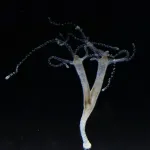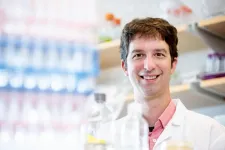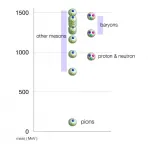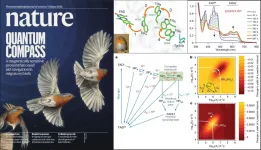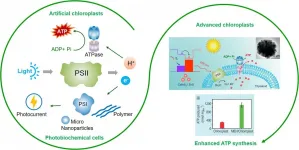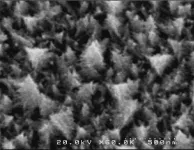(Press-News.org) Russia is the world's largest forest country. Being home to more than a fifth of forests globally, the country's forests and forestry have enormous potential to contribute to making a global impact in terms of climate mitigation. A new study by IIASA researchers, Russian experts, and other international colleagues have produced new estimates of biomass contained in Russian forests, confirming a substantial increase over the last few decades.
Since the dissolution of the USSR, Russia has been reporting almost no changes in its forests, while data obtained from remote sensing products indicate that Russian forests have in fact experienced an increase in vegetation productivity, tree cover, and above-ground biomass in the last few decades. This has led to inconsistencies in available data and a general decline in the reliability of information on Russian forests since 1988, which can be attributed to an information gap that appeared when Russia moved from the Soviet Forest Inventory and Planning system to its current National Forest Inventory (NFI) for the collection of forest information at the national scale. The first cycle of the Russian NFI was finalized in 2020. The authors of a new IIASA-led study published in Nature Scientific Reports have used this data in combination with research forest plots on the ground and remote sensing data, in an advanced analysis to produce a new estimate of the biomass of Russian forests, confirming these forests' climate change impact and their importance for climate change mitigation.
"We set out to determine the live biomass stock and sequestration rate of Russian forests. The joint efforts of our diverse team consisting of representatives from the Russian state forestry agency, forest survey, academic research institutes, and other educational institutions, made it possible for us to produce an important, reproducible scientific result. Even more importantly, our work contributed to building mutual trust, a policy of data sharing, and hopefully, the potential for fruitful future collaboration," says study lead author Dmitry Schepaschenko, a researcher with the IIASA Agriculture, Forestry, and Ecosystem Services Research Group in the Biodiversity and Natural Resources Program.
The team were the first to be given access to a portion of primary NFI plot data with precise location information, which, as in many other countries, is normally restricted for sharing and use, under the condition that the initial data processing was physically undertaken on site at the authorized division ("Roslesinforg") of the Federal Forestry. The researchers used this data in combination with remote sensing data to estimate the growing stock of Russian forests and to assess the relative changes in post-Soviet Russia. They calibrated models relating to two global remote sensing biomass data products and additional remote sensing data layers with around 10,000 ground plots from the NFI and the Forest Observation System to reduce uncertainties and produce an unbiased estimation at jurisdictional level. By combining these two sources of information, the team were able to utilize the advantages of both sources in terms of highly accurate ground measurements and the spatially comprehensive coverage of remote sensing products and methods.
"Quite often, practitioners simply use linear regression by default without checking the underlying statistical assumptions or worrying about the difference between the ability of a model to explain the observed data and the ability to predict the future or unobserved data. Because the aim of this study was to estimate the unobserved biomass, we have used modern computationally intensive methods to focus on the goodness-of-prediction of a range of plausible models," explains study coauthor and long-time IIASA collaborator, Elena Moltchanova from the School of Mathematics and Statistics at the University of Canterbury, New Zealand.
The findings indicate that Russian forests have in fact accumulated a large amount of biomass - in the range of 40% more than the value recorded in the country's State Forest Register and reported to the statistics of the Food and Agriculture Organization of the United Nations (FAO). Using the last Soviet Union report as a reference, the results show that the growing stock accumulation rate in Russian forests between 1988 and 2014 is of the same amplitude as the net forest stock losses in tropical countries. The study's estimate of carbon sequestration in live biomass of managed forests between 1988 and 2014 is 47% higher than reported in the National Greenhouse Gases Inventory.
The authors note that while Russian forests and forestry have great potential in terms of global climate mitigation as well as numerous potential co-benefits relating to the green economy and sustainable development, it is important to highlight that as the climate becomes more severe, as in recent years, resulting forest disturbances might nullify these gains. Close collaboration of science and policy would therefore be critical to elaborate and implement adaptive forest management.
"We are talking here about the largest country in the world hosting the largest share of the largest land biome globally - the circumboreal belt of forest - which is highly climate relevant. Imagine what just a few percent up or down with regard to the amount of forest biomass available and its consequent carbon sequestration potential can make globally," says Agriculture, Forestry, and Ecosystem Services Research Group Leader and study coauthor, Florian Kraxner. "This study once again highlights the important work done by researchers of the International Boreal Forest Research Association (IBFRA), which we would like to acknowledge particularly," he concludes.
INFORMATION:
Reference
Shchepashchenko, D., Moltchanova, E., Fedorov, S., Karminov, V., Ontikov, P., Santoro, M., See, L., Kositsyn, V., et al. (2021). Russian forest sequesters substantially more carbon than previously reported. Scientific Reports 11 (1) e12825. DOI: 10.1038/s41598-021-92152-9 [pure.iiasa.ac.at/1720]
Contacts:
Researcher contact
Dmitry Shchepashchenko
Senior Research Scholar
Agriculture, Forestry, and Ecosystem Services Research Group
Biodiversity and Natural Resources Program
Tel: +43 2236 807 453
schepd@iiasa.ac.at
Florian Kraxner
Research Group Leader
Agriculture, Forestry, and Ecosystem Services Research Group
Biodiversity and Natural Resources Program
Tel: +43 2236 807 233
kraxner@iiasa.ac.at
Press Officer
Ansa Heyl
IIASA Press Office
Tel: +43 2236 807 574
Mob: +43 676 83 807 574
heyl@iiasa.ac.at
About IIASA:
The International Institute for Applied Systems Analysis (IIASA) is an international scientific institute that conducts research into the critical issues of global environmental, economic, technological, and social change that we face in the twenty-first century. Our findings provide valuable options to policymakers to shape the future of our changing world. IIASA is independent and funded by prestigious research funding agencies in Africa, the Americas, Asia, and Europe. http://www.iiasa.ac.at
In the animal kingdom, specific growth factors control body axis development. These signalling molecules are produced by a small group of cells at one end of the embryo to be distributed in a graded fashion toward the opposite pole. Through this process, discrete spatial patterns arise that determine the correct formation of the head-foot axis. A research team at the Centre for Organismal Studies (COS) at Heidelberg University recently discovered an enzyme in the freshwater polyp Hydra that critically shapes this process by limiting the activity of certain growth factors.
In particular, the proteins of the so-called Wnt signalling pathway play an important role in the pattern formation of the primary ...
MINNEAPOLIS/ST. PAUL (06/24/2021) -- A study led by researchers at the University of Minnesota Medical School sheds new light on boys' weapon-carrying behaviors at U.S. high schools. The results indicate that weapon-carrying is not tied to students' race or ethnicity but rather their schools' social climates.
The study was published in the journal Pediatrics and led by Patricia Jewett, PhD, a researcher in the Department of Medicine at the U of M Medical School.
"Narratives of violence in the U.S. have been distorted by racist stereotyping, portraying male individuals of color as more dangerous than white males," Jewett said. "Instead, our study suggests that school climates may be linked to an increase in weapon-carrying at schools."
The ...
Researchers at UCSF have found that extreme caloric restriction diets alter the microbiome in ways that could help with weight loss but might also result in an increased population of Clostridiodes difficile, a pathogenic bacterium that can lead to severe diarrhea and colitis.
Such diets, which allow people only 800 calories per day in liquid form, are an effective approach to weight loss in people with obesity. The unexpected results of this study raise the question of how much the microbiome influences weight loss and which bacteria are significant in that process. The study appears in the June 23, 2021, issue of Nature.
"Our results underscore that the role of calories in weight ...
Using only a pen and paper, a theoretical physicist has proved a decades-old claim that a strong force called Quantum Chromo Dynamics (QCD) leads to light-weight pions, reports a new study published on June 23 in Physical Review Letters.
The strong force is responsible for many things in our Universe, from making the Sun shine, to keeping quarks inside protons. This is important because it makes sure that the protons and neutrons bind to form nuclei of every atom that exists. But there is still a lot of mystery surrounding the strong force. Einstein's relation E=mc2 means a strong force leads to more energy, and more energy means a heavier mass. But subatomic particles called pions ...
Recently, a collaboration of researchers from the Hefei Institutes of Physical Science (HFIPS), Universities of Oldenburg (Germany) and Oxford (UK) have been gathering evidence suggesting that a specific light-sensitive protein in the eye named cryptochrome 4 is sensitive to magnetic fields and plays essential roles in magnetic sensing in migratory birds such as European robins. The results have been published in Nature (https://doi.org/10.1038/s41586-021-03618-9) on June 23 and selected as the cover paper.
For the first time, first author XU Jingjing, a doctoral student in Mouritsen's research group at Oldenburg, with the help of XIE's group, produced cryptochrome 4 in night-migratory ...
BIRMINGHAM, Ala. - A bout with flu virus can be hard, but when Streptococcus pneumonia enters the mix, it can turn deadly.
Now researchers have found a further reason for the severity of this dual infection by identifying a new virulence mechanism for a surface protein on the pneumonia-causing bacteria S. pneumoniae. This insight comes more than three decades after discovery of that surface protein, called pneumococcal surface protein A, or PspA.
This new mechanism had been missed in the past because it facilitates bacterial adherence only to dead or dying lung epithelial cells, not to living cells. Heretofore, researchers typically used healthy lung ...
Ultrasound can overcome some of the detrimental effects of ageing and dementia without the need to cross the blood-brain barrier, Queensland Brain Institute researchers have found.
Professor Jürgen Götz led a multidisciplinary team at QBI's Clem Jones Centre for Ageing Dementia Research who showed low-intensity ultrasound effectively restored cognition without opening the barrier in mice models.
The findings provide a potential new avenue for the non-invasive technology and will help clinicians tailor medical treatments that consider an individual's disease progression and cognitive decline.
"Historically, ...
Are the traditional practices tied to endangered species at risk of being lost? The answer is yes, according to the authors of an ethnographic study published in the University of Guam peer-reviewed journal Pacific Asia Inquiry. But the authors also say a recovery plan can protect both the species as well as the traditional CHamoru practice of consuming them.
Else Demeulenaere, lead author of the study and associate director of the UOG Center for Island Sustainability, presented on their findings during the Marianas Terrestrial Conservation Conference on June 8.
Strong ...
In the recent decade, scientists have paid more attention to studying light harvest for producing novel bionic materials or integrating naturally biological components into synthetic systems. Inspiration is the imitation of natural photosynthesis in green plants, algae, and cyanobacteria to convert light energy into chemical energy. Photosystem II (PSII) is a light-intervened protein complex responsible for the light harvest and water splitting to release O2, protons, and electrons. The development of PSII-based biomimetic assembly in vitro is favorable for the investigation of photocatalysis, biological solar cells, and bionic photosynthesis, further help us reveal more secret of photosynthesis.
The combination of PSII and artificially synthetic structures is successful for ...
Ishikawa, Japan - Nanostructured metal surface has novel physical and chemical properties, which have sparked scientific interest for heterogeneous catalysis, biosensors, and electrocatalysis. The fabrication process can influence the shapes and sizes of metal nanostructures. Among various fabrication processes, the electrochemical deposition technique is widely used for clean metal nanostructures. Applying the technique, a team of researchers led by Dr. Yuki Nagao, Associate Professor at Japan Advanced Institute of Science and Technology (JAIST) and Md. Mahmudul Hasan, a PhD student at JAIST, succeeded to construct Pd-based catalysts having unique morphology.
In this study, the team has successfully synthesized Christmas-tree-shaped palladium nanostructures on the GCE ...
